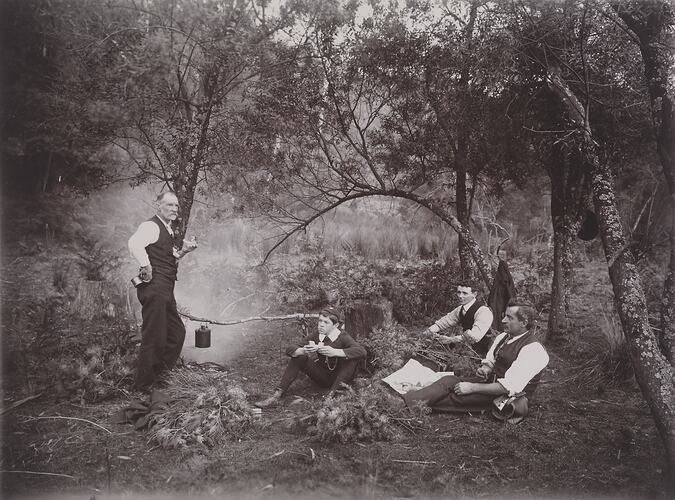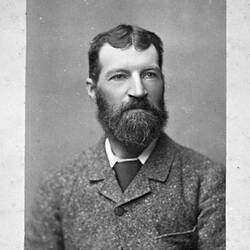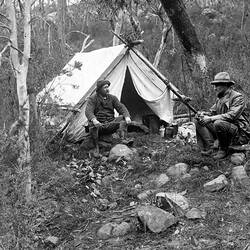Summary
This self-portrait of Campbell, his sons Archibald Geroge and Charles and a friend was taken in the Dangenong Ranges around 1900. The group rest after a successful expedition, collecting Wattle. Archibald James Campbell leaning against a tree waiting is waiting for the billie to boil. The rest of the party are seated by the camp fire eating luch. A well known Naturalist, Campbell is acknowledged as one of the first nature photographers in Australia and here his adoration of the Wattle and his nature photography come together.
Campbell long argued for recognition of Wattle as a symbol of Australian patriotism. Campbell promoted spring excursions in search of wattle to establish the Wattle Club in 1899, and conduct annual expeditions on 1 September to collect wattle. In 1908 he delievered a lecture which became very popular, "Wattle Time; or Yellow-haired September," and in it he advocated for a National Wattle Day. Wider acceptance of a national Wattle Day was achieved at a major Australian Wattle Day League Conference in Melbourne in January 1913. Branches were formed in a number of States, with the general aim of officially proclaiming wattle as the national floral emblem and extending Wattle Day celebrations throughout the nation. About this time, wattle was officially introduced to representations of the Commonwealth coat-of-arms. And in December of the same year, the first wattle blossom stamp was issued. As public support for Wattle Day reached a peak, World War I broke out. Wattle took on a new significance in the war years as a potent symbol of home for military personnel serving overseas, and as a means of raising money for organisations such as the Red Cross. Beautifully designed Wattle Day badges as well as wattle sprigs were sold. Ironically, the destruction of wattle for Wattle Day displays and fund-raising sales reached such heights that farmers within an hour of Melbourne locked their gates and wrote angry letters to newspapers. The use of badges depicting wattle instead of actual wattle saved many blooms. Campbell notes that this variety of Wattle, Acacia longifolia "cuts well and flowers freely - the new wood beautiful in spring by reason of the catkin-like flowers."
Description of Content
Two men and a young boy sit in the bush eating a picknic lunch. Older man stands holdings a metal cup and eating a sandwich. Between them a billie is hanging on a stick over a fire.
More Information
-
Collection Names
-
Collecting Areas
-
Acquisition Information
Transfer from Natural Science, Museum Victoria
-
Place & Date Depicted
Dandenong Ranges, Victoria, Australia, circa 1900
There was a previous note that this image was taken Jan 1895. No evidence as been found for this elsewhere, so based on the apparent age of Campbell's son in the image has been given a new date of circa 1900 - Rebecca Carland, June 2007. -
Creator
Archibald J. Campbell, circa 1900
There was a previous note that this image was taken Jan 1895. No evidence as been found for this elsewhere, so based on the apparent age of Campbell's son in the image has been given a new date of circa 1900 - Rebecca Carland, June 2007. -
Person Depicted
-
Format
Photograph, Black & White
-
Classification
-
Category
-
Discipline
-
Type of item
-
Dimensions
21.5 cm (Width), 15 cm (Height)
-
Keywords


